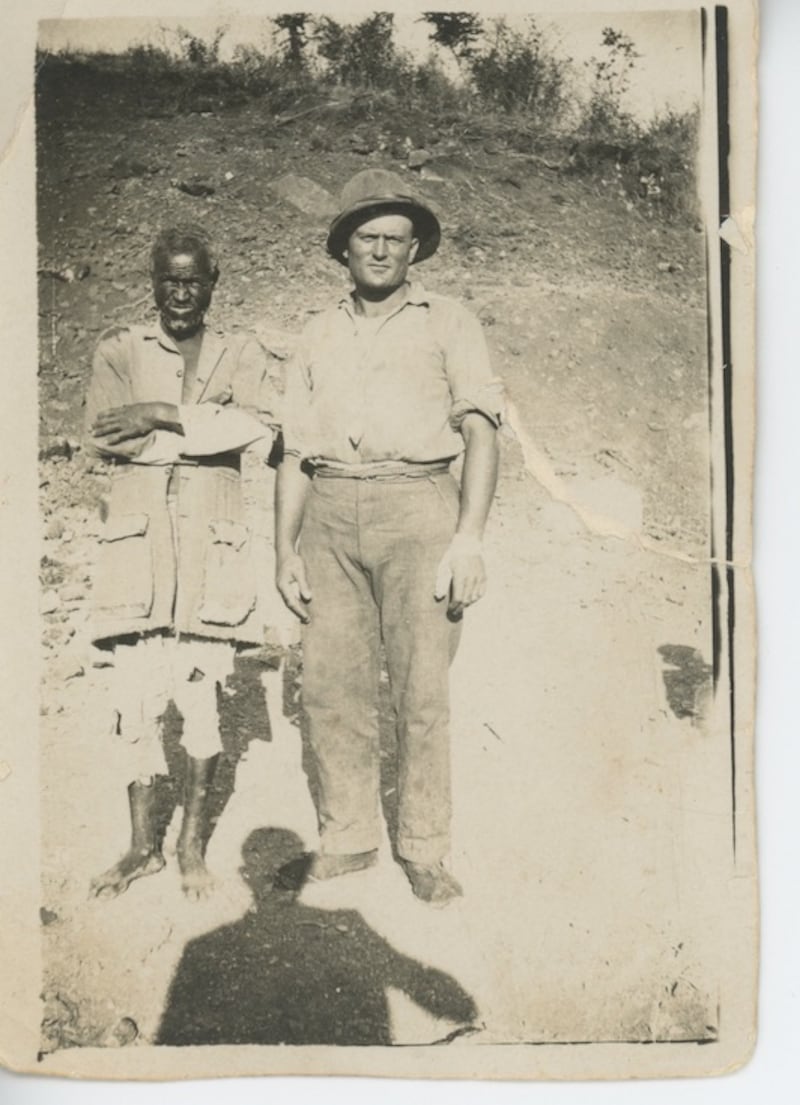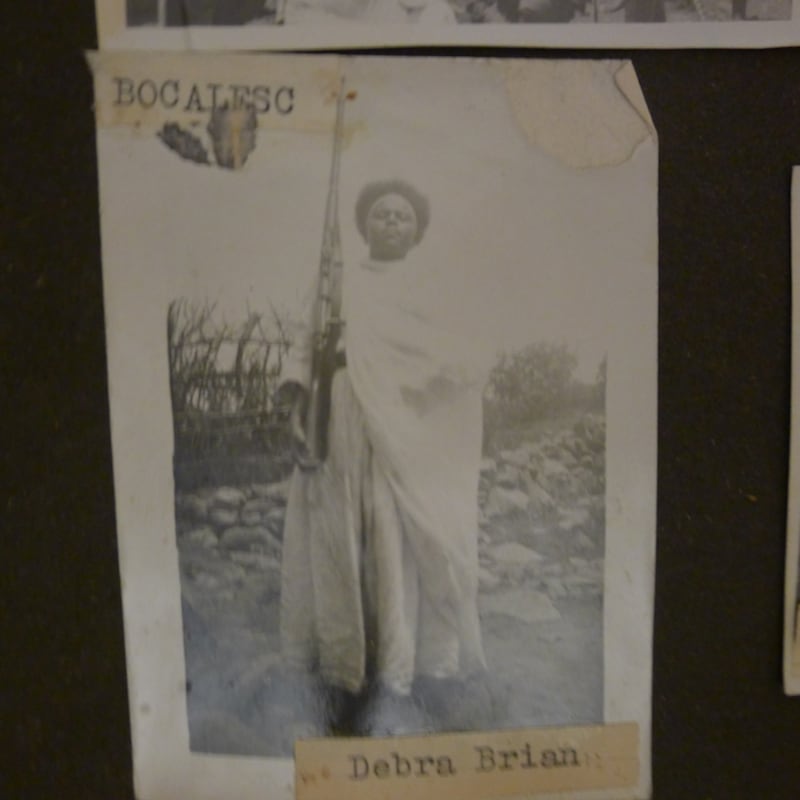I own an old black and white photograph of two men standing side by side, inches apart from each other. One is East African and the other, Italian. The East African, either Ethiopian or Eritrean, wears frayed shorts so old and worn that large patches of skin gape through the holes. The bottoms are ripped unevenly, narrowing raggedly and stopping at his calves. An oversized jacket sags against his slender frame, the open flaps exposing his bare chest.
He squints into the camera with a lowered chin, his mouth a grim line. The Italian beside him is fully clothed with a hat perched at an angle on his head. It shields his face from the worst of the sun, and so he is able to gaze forward undisturbed. Though there are two men here, it is him that the photographer has placed neatly in the middle of the frame. He is the central figure, the one that cuts the vertical photograph in half.
I no longer recall where I found this photograph. What I remember instead is the moment of encounter with it – that first jolt of recognition that I was looking at something, even though I could not yet understand what it was.

In 1935, Benito Mussolini invaded Ethiopia to colonize the country. It was not fair that Britain, France, Germany, Belgium and other countries had staked a claim on the African continent without Italy. It was, he stated, Italy’s right to have a “place in the sun”. Fascism would establish a second Roman Empire on African soil, and it would do so by conquering Ethiopia.
I knew all of this when I first encountered this photograph. Though I couldn’t be certain of the date, I could make an informed guess that this image was made after the October 1935 invasion. War had likely already started, and though Benito Mussolini declared victory in May 1936, I knew this would prove to be premature. The war would simply shift from traditional confrontations to guerrilla warfare. Perhaps this photograph was made in that chaotic period between the declaration of victory and the start of guerrilla war. Perhaps what I was looking at was an image of instability and uncertainty; the Italians. Maybe the ground that rises sharply behind the two men hides entire armies of Ethiopians waiting for dark to ambush.
I cannot do that. I cannot will a narrative onto this picture that probably did not exist. The urge is strong, and while I might be able to excuse myself by pointing to the brutalities of war, and, in particular, this war, I have to refuse the instinct to protect and maybe save this man. I have to see what is there without smoothing out the rough edges of history. It is too easy to put myself into the photograph and reach into the past to settle the pieces into some reassuring order.
It eases confusion; it leaves me satisfied in the present. But it also stops the recursive nagging contemplations that could lead me to other discoveries, because it is more difficult to reckon with the unwieldiness of history’s omissions. It is uncomfortable to admit that photographs and other documents in other archives only lead to other questions and new uncertainties. Because, if we cannot fully know the past, what does it imply about how we imagine the future?
We have been taught for so long that an answer must always follow a question – that if we cannot point to a resolution then we have failed. But what if, in that space between knowing and confusion, is an entire landscape where something else beyond answers but equally vital exists? What if, cradled within each moment of encounter, is a force that can lead us towards real transformation? What if to be disturbed is just one step towards that journey? What if every step forward takes us not into the territory of comfort and certainty, but towards new disruptions and greater leaps?
It has taken me a long time to understand what I sensed but could not initially see. It has taken other photographs and other encounters to recognize the ghosts hovering at the edges of that image. Those invisible threads that connect us to the past, those things we describe in language that is as indefinite and unclear as what we feel in that first moment of encounter.
Let me go back for a minute. When Italy invaded Ethiopia, no one really expected Ethiopia to defeat the giant. The army was untrained in tactics of modern warfare. Fascist Italy on the other hand was known as one of the largest and most modern military forces in the world. It had perfected air warfare and the use of poison gas to devastating effect in Libya. Still stinging from Italy’s defeat in 1896, Mussolini vowed to pour every resource into this war to prove to the world Italy’s might. This was, as much as anything, an exhibition of Italian prowess. It was an effort to debunk the stereotypes of Italy as an affable, irresponsible Mediterranean country, and present a muscular and violent European power. It was also a carefully orchestrated campaign to promote a cohesive Italian identity, one that melded an idealized masculinity with a devotion to fascism. Young men were encouraged to enlist in the new African adventure with promises of sexually compliant East African women.
I have in my possession a certain album. The first photograph depicts a young Ethiopian woman reclining on a rock propped on her elbow and squinting into the sun. A valley unfolds in wide, easy sweeps over her bare shoulders. That she is naked from the waist up is an uncomfortable detail, but it is not unusual.
I was taken aback by the careful arrangement of the album. Many photographs included a label with the woman's name. The cities indicated formed a zigzag across Ethiopia. Most included the dates 1936 or 1937. At times, as if it was unacceptable to leave a picture unmarked, a label simply announced the subject as donna abissina – Abyssinian woman. This album was curated, photos organized and meticulously labelled, guided by a patient eye. It was a detailed, carefully crafted story of one man's time in Ethiopia – a way to speak of this great African adventure.

There was one photo, though, that was different from the rest. Towards the end of the album is a picture of a woman named Bogalech from Debre Berhan. Unlike the others, she is fully clothed in her traditional Ethiopian dress. She has a shawl draped across one shoulder and stands with her chin raised, a rifle in her hand. The muzzle is pointed up as if it were aimed at the sky. Bogalech is not afraid, nor is she demure. She looks determined and resilient; strong. She is a startling vision in an album such as this, and, for a while, eager to strip away the awful residue of those other photos, I convinced myself that it was a positive portrayal of an African woman. Taken on its own it might have symbolized the photographer’s leanings towards a more complex understanding of women.
But I was doing it again. Do you see that? I was reaching into the past to smooth the edges, because what I could not immediately accept was that, in an album otherwise full of exploitative images of women, the photo of a woman with a gun becomes not a sign of female strength but a mockery of it. Her implied weakness is exposed by all the other pictures that came before her. This woman, Bogalech, is bound by their fate. They are the ghosts that hover behind her and out of frame.
When I looked at her, I needed to see these other women. I needed to see the album. I needed to see the hands that made the album, that pasted the labels, that propped the camera in front of his eye and clicked the shutter to photograph not a woman but power and manhood. When I looked at her, I needed to see him, because what her picture was, in essence, was a self-portrait of this photographer.
He was impossible to see without those women, without Bogalech, without the discomfort that brought me back again and again to that first sighting – that first disruption. There he is, not the answer to a question but a path towards another kind of journey, one that considers what is there, even with all the unknowns, and what we can learn from it, from him, about power and manhood, about ways of seeing and the uncomfortable terrain between confusion and a kind of transformation that provides new questions and urges greater leaps into other, uncharted territory.
What does it mean to now see this photographer in this photograph? What does it mean to recognize the many ways that those in power make images of themselves, no matter what is actually standing in front of us, hands folded across a chest, while squinting into the sun.
This is an excerpt from Maaza Mengiste's 2021 Annual Pluralism Lecture for the Global Centre for Pluralism. She is the auhtor of the Booker-shortlisted The Shadow King










